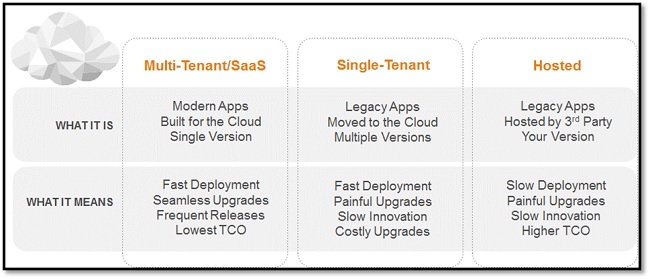
Why Multi-Tenant Cloud Applications Matter
What's the best option for companies interested in gaining the maximum cost advantages from a move to the cloud?
- By John O'Rourke
- April 1, 2016
In 2015, the IT industry appeared to reach the tipping point in the transition from on-premises to cloud-based applications. Following years of rapid cloud-based application adoption in sales, marketing, human resources, and even finance got on the bandwagon in 2015. This was evident in a 2015 survey by Gartner and FEI where increasing number of respondents indicated they had already deployed, were in the process or planning to deploy their business applications in the cloud. This included:
- Payroll (65%)
- CRM (57%)
- T&E management (57%)
- Financials (53%)
- Management Reporting (49%)
- Modeling/Business Analytics (46%)
- Budgeting/Planning (45%)
As a result of this shift in customer preference, just about every business application software vendor is now claiming they have "cloud" applications, but not all cloud solutions are created equal. Make sure you understand the different flavors of cloud that are available and especially what the cost implications are of the various deployment models.
Not All Clouds Are Created Equal
With customer preference now trending toward cloud-based applications, a number of business software vendors jumped on the cloud bandwagon in 2015. The mega-vendors (Oracle, SAP, and IBM) all made announcements or delivered cloud-based applications. We also saw other traditional on-premises application vendors announce cloud-based versions of their products.
However, industry watchers such as Forrester Research have been cautioning buyers to be aware of "false clouds" and to ensure they understand the architecture of the cloud solutions they're considering. While everyone is using the term "cloud," not all clouds are created equal. A variety of deployment models fit under this moniker -- each with different value propositions for customers.
Here's a quick recap of the different approaches to "cloud" applications available in the market.
Hosted applications: The legacy software vendor or a third party installs the on-premises application in its own hardware infrastructure and hosts the application on behalf of the customer. Customers still have their own instance of the software, but it relieves them of the need to set up infrastructure and install the software themselves. Everything else is the same as in the on-premises environment: licensing, configuration, maintenance, upgrades, support, etc. Of all three models, hosted applications have the highest costs.
Single-Tenant cloud: The legacy software vendor sets up a cloud infrastructure and makes the application available to a number of customers, typically on a subscription basis. Customers are relieved of the infrastructure requirement and they avoid the high up-front licensing associated with on-premises or hosted applications. Because customers have their own "instance" set up in the cloud, the upgrade process is still painful and costly, and new releases aren't rolled out automatically, or frequently. Also, in many cases, the features offered in the cloud version of the software are more limited than those available in the on-premises version.
Multi-Tenant cloud: These applications are built from the start to be deployed on a shared infrastructure, with a single application code base shared by a large number of customers. Because the infrastructure and software installation process is eliminated, applications can be provisioned and configured rapidly for new customers. The software is sold on a subscription basis so it removes the up-front licensing costs of on-premises or hosted applications. Because there's a single code base, all customers are using the same version of the software, which is upgraded automatically on a frequent basis and usually at no cost.
The table below summarizes the three approaches to cloud applications and the trade-offs between them.

The industry has recognized the advantage of true, multi-tenant cloud applications over the single-tenant and hosted models:
- Speed: New applications can be deployed and configured within weeks
- Autonomy: No need for IT support; departments can control their own destiny
- Innovation: Application updates are released rapidly, typically quarterly
- Total cost of ownership (TCO): Costs are lower since configuration is easier and software updates are automated.
This last factor -- cost -- is what makes a significant difference to customers in adopting multi-tenant vs. single-tenant or hosted software. Let's take a closer look at this issue.
The Advantage of Multi-Tenant SaaS: Costs
In examining the cost advantages of multi-tenant vs. single-tenant or hosted applications, customers will see differences in a several areas:
Provisioning the software: Customers will incur the greatest costs under the hosted model due to up-front license fees and set-up fees for the hardware and software infrastructure. These are reduced under the single- and multi-tenant deployment models becayse the vendor already has the infrastructure and software in place.
Configuring the system: The steps required to configure the application for a specific company are mostly the same across the three models. Examples include defining the chart of accounts, setting up hierarchies, creating business rules, setting up user security, and writing reports. However, applications that were built natively for the cloud are typically easier to configure than are on-premises applications that were moved to the cloud (which may require more IT support to set up than do multi-tenant applications, which have greater end-user-oriented administrative features.
Data integration: An important step often lacking in hosted or single-tenant applications is data integration, especially for business analytics tools and applications. This is often achieved via flat files and requires manual setup and ongoing hand-holding. True multi-tenant cloud vendors typically provide cloud-based data integration tools that can access data directly from both on-premises and cloud-based applications.
Running the system day to day, week to week: The end-user interaction with the application will likely be similar across the three deployment models. One thing to be aware of is who is responsible for database maintenance and back-ups under the hosted model. That may still be the responsibility of the customer, which will add costs to the equation.
Updates and upgrades: This is a big area of differentiation across the three deployment models. Updates to the operating system, database, and application software will be the most time-consuming and expensive under the hosted model. They will be less costly under the single- and multi-tenant models because the vendor is taking responsibility for the updates and upgrades to all of the software layers. However, under the single-tenant model, the updates will typically come less frequently but require more planning and downtime by the customer. In the multi-tenant model, software feature updates are more frequent, automatic, and seamless, occurring in a shorter maintenance window.
One additional thing to be aware of is what happens when a legacy, on-premises business applications vendor moves its applications to the cloud. If the on-premises solution is based on a non-integrated set of standalone applications (as many are), this won't change as these applications are moved to the cloud.
There will still be multiple points of maintenance and administration for the various modules. You will still need to somehow share data across the modules to perform actual vs. budget reporting, run complex allocations, or conduct multi-dimensional analysis, so the costs of using and running the system will remain the same as the costs for the on-premises deployment.
Achieving the Lowest Possible TCO
What's the best option for companies interested in gaining the maximum cost advantages from a move to the cloud? The answer is that business applications that were designed from inception to be deployed as a multi-tenant cloud solution will offer the lowest TCO of all three models. Native cloud applications will be easier and less costly to deploy, integrate, run, maintain, and upgrade.
The shift to cloud-based applications is a major change that is transforming the IT industry and transforming business. There's also a lot of "hype" in the market because every business application software vendor moves quickly to announce their cloud applications. Not all cloud solutions are created equal. Make sure you understand the cloud architecture of any vendors you are evaluating and the true costs of deploying and maintaining that vendor's applications.
About the Author
John O'Rourke is vice president of product marketing at Host Analytics. With a background in accounting and finance, John has over 30 years of experience in the software industry and over 16 years of experience in EPM product marketing at Hyperion Solutions and Oracle. He has worked with many customers and partners on financial reporting and planning initiatives and has spoken and written on many topics in enterprise performance management. John has held positions in strategic marketing and product marketing at Dun & Bradstreet Software, Kenan Systems, and Decisyon. He holds a BS degree in accounting from Bentley University and an MBA from Boston College.